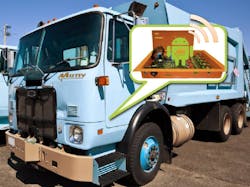The electric truck: How one firm is giving fleets a choice
A San Francisco start-up company is looking to fill in a “gap” that its CEO says exist in the commercial electric vehicle market. According to Jim Castelaz, CEO of Motiv Power Systems, a company that launched in 2009, there are limited choices in the industry when it comes to electric vehicle options for fleets.
“We want to fill this gap that is missing within the industry,” he says. “Fleets are used to being able to customize their vehicles…and I think the electric chassis out there are limited.”
And there is interest out there in the product, as evidenced by a contract worth up to $13.4 million the city of Chicago recently awarded the company to supply all-electric Class 8 refuse trucks.
“What we offer is really a suite of controllers; it’s the glue,” he says. “We’re trying to give fleets like Chicago the option to [get the trucks they want].”
The Motiv system operates like a quarterback of a football team. While it takes lineman, receivers and running backs working together for a team to score, without a quarterback, nothing good will happen. The Motiv system is really a software and hardware solution that brings together different components of an electric-drive system and coordinates the operation of the system into a highly efficient power source.
According to Castelaz, the beauty of the system is its cost savings. Off-the-shelf batteries can be used and bundled together (even from different manufacturers) to provide the power needed. This approach, he says, is more cost efficient than building a bigger battery system and allows vehicles such as Class 8 refuse trucks to generate as much power as needed.
Other components can also be mixed and matched, allowing fleets the option to pick components based on their own criteria, be that power, reliability, or price. It also reduces maintenance costs, Castelaz claims. For instance, if a battery pack goes bad, the entire pack must be replaced at significant cost. Under that same scenario, though, a truck running the Motiv system only needs to replace the one battery that has gone bad, resulting in further savings and extending the useful life of the vehicle.
The best advantage? The ability to electrify nearly any type of chassis, Castelaz points out. Over the past nine months or so, Motiv has been testing an all-electric Ford E-450 cutaway chassis bus running the system. The contract with Chicago will be the first implementation of the system on a Class 8 vehicle, but Castelaz says that the flexibility and scalability of the system is such that a wide range of chassis could operate using the system.
“If you look at very heavy vehicles like locomotives, they’ve been moved by electric motors for years,” Castelaz says, so the power necessary to drive commercial vehicles is certainly doable. “I think there is a real segment and need for electric vehicles.”
That need extends beyond just electric vehicles, as we’ve all learned. Alternative options ranging from electric, to hybrid, to natural gas are starting to penetrate the market and Motiv’s system is just another potential option out there. Where it fits at this point is anyone’s guess, but given the questions that have been arising of late about the future of electric vehicles – both commercial and consumer – perhaps the “plug-and-play” option is coming along at just the right time.

